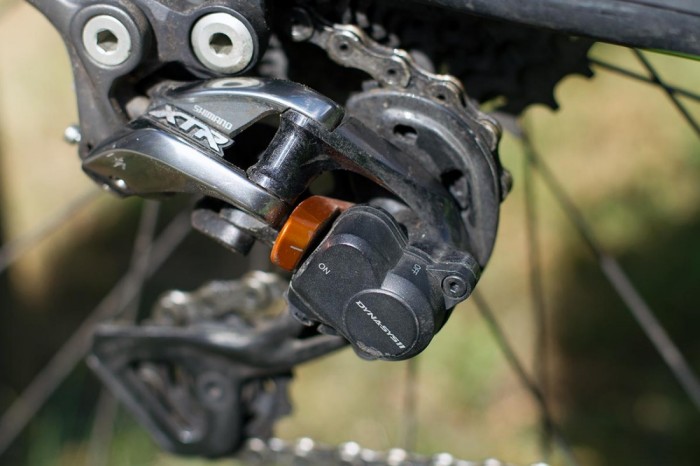Shimano’s XTR has had a big 12 months. The introduction of the Di2 version of the group amid (justified) fanfare last year came just after the introduction of the M9000 groupset – Shimano’s first 11-speed mountain bike group.
I’ve had the pleasure of living with the latter addition for five of those months. Specifically a 1×11 (32T/11-40T) setup on my Whyte 29C – the bike that will travel with me to Mongolia next month for the Mongolia Bike Challenge.
It’s perhaps no coincidence that the arrival of 11-speed groups marries up with the trend towards single chainring setups (though 2x and 3x cranksets remain an option for M9000). This was my first foray into this brave new world and I’ve quickly become a convert. For marathon/XC riding the combination of single chainring and 11-40 cassette should take care of anything you’re likely to come across out on the trails; that’s certainly been my experience over the past 5 months. Your own needs might be different, but the close ratios of Shimano’s 2x crankset are set to provide a much smoother shift than any previous incarnation.
Only what’s required. The 1x crankset on Shimano’s XTR M9000 groupset. Photo: Richie Tyler
All the gear
The 11-speed cassette provides ample gearing range for any gradient I’ve come across in the past five months. In fact, it’s made me realise that most of us have probably been lugging around redundant gear ratios for years. Essentially, the XTR 1×11 setup is a rationalisation of what gearing is required for most cross-country style riding. Less-is-more in action.
Plenty of room when you take a front derailleur out of the equation. Photo: Richie Tyler
Shimano XTR 11-speed. Count ’em. Photo: Richie Tyler
The nett effect of the 11-speed groupset is even smoother shifting across the gear range. This is no surprise, as the tighter blend of ratios reduces leaps between gears. With no experience of its predecessor, I can’t claim to identify improvements in the XTR Shadow rear derailleur, but based on my experience with M9000 so far (and past experience with XT-level groups and SRAM X11), the rear mech has provided exceptional shifting performance – especially under load on scrambly climbs over shifting surfaces. The shift action remains light, and the derailleur sits very close to the bike, out of harms way.
The XTR M9000 rear derailleur provides crisp shifting across the 11-speed cassette. Photo: Richie Tyler
Stopping power
One of the most striking things about the M9020 (Trail) brakeset is the cooling fins that adorn the front and rear calipers. It’s a fairly subjective call, but on longer descents (when I probably shouldn’t have been on the brakes as much as I was) the brakes maintain consistent performance.
The cooling fins are a beautifully functional addition to Shimano’s XTR M9020 brakeset. Photo: Richie Tyler
Shimano XTR M9020 front Caliper and disc rotor. Photo: Richie Tyler
Reviews of brakes often use modulation as a bit of a throwaway jargon. Essentially, it’s the relationship between the power you put into the lever vs the stopping power. Better modulation, better control. In this regard, the M9020 are a standout of the XTR family. Stopping power builds smoothly through the lever range. There simply isn’t the sense of on/off I’ve experienced with lower tier groups in the past.
As I mentioned, the caliper fins are a beautifully functional touch, as are the levers. Elegance is not a word necessarily synonymous with mountain biking – especially after a day in the dirt – but the combination of carbon fibre levers, magnesium master cylinder body and titanium bolts leaves few other adjectives. Aiding his is the size of the master cylinder is about the width of a pen. Neat, to say the least.
Elegant profile and excellent control. Shimano XTR M9020 brake levers. Photo: Richie Tyler
With only one derailleur to worry about Shimano XTR M9000 shift levers nestle neatly behind the front brake lever. Photo: Richie Tyler
A Pro Partnership
Although sitting beyond the boundaries of the XTR groupset I’d be remiss not to remark on the Pro components I’ve been using these past few months, as they’ve been something of a revelation.
The first two things I though I’d be changing on my bike were my saddle and handlebar, but both have proven an essential part of what has been an brilliant five months on this bike so far.
Pro’s Tharsis bars have been awesome so far. Photo: Richie Tyler
The sweep of Pro’s carbon Tharsis bars has been bang-on. I’d contemplated switching to a straight bar (habit more than anything), but I quickly came to love the control the 740mm affords me on windy sections of trail.
Pro’s Turnix saddle has been a revelation so far. Photo: Richie Tyler
Pro’s Turnix saddle, too, has proven to be a good match for my anatomy. As we all well know, saddles can be a hit-and-miss affair. There’s a few big players that dominate the market, but from my experience thus far, Pro will be on my list when it comes time to replace my perch on other bikes.
The interesting faceplate for Pro’s XCR stem. Photo: Richie Tyler
All clear in the cockpit with Shimano XTR 1×11 and Pro’s Tharsis bars. Photo: Richie Tyler
The non-drive side crank arm of Shimano’s XTR M9000 Groupset. Photo: Richie Tyler
Our test group featured a prototype of the crankset, but production is well underway. Photo: Richie Tyler
With no derailleur to worry about, the M9000 1x crankset eschews ramps and pins in favour of squarer teeth. Photo: Richie Tyler
For XC/marathon racing, less is more with Shimano’s XTR M9000 1×11 setup. Photo: Richie Tyler
Shifting is a breeze with easy access to thumb and trigger shift levers. Photo: RIchie Tyler

